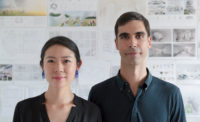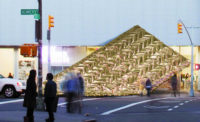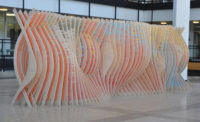Winning a competition like New Practices New York—AIA New York’s platform for recognizing emerging talent—can propel a young studio’s growth, as this year’s winners Ines Guzman Mendez and Gregory Kahn Melitonov learned. After their New York– and Guatemala City–based studio Taller Ken was honored, the partners received almost three dozen résumés.
“We had no projects to hire for,” Melitonov, 35, says, “and how were we going to compare the experience of someone from Kazakhstan to a Columbia student?” Instead of ignoring the sudden attention of designers looking for jobs, he and Mendez channeled it for good, inviting everyone to Guatemala City for a newly hatched design-build workshop. Nine applicants accepted. The $1,000 New Practices prize money and Indiegogo donations will fund construction of a local project (to be decided) and stipends.
This team mentality harkens back to Melitonov and Mendez’s formative studio experiences at Renzo Piano Building Workshop, where they met while working on the new Whitney Museum of American Art in 2010, just six weeks after Melitonov graduated from Yale’s architecture school. RPBW made a point of recruiting interns from far-flung schools and encouraging these hires to take on responsibility. Mendez, 32, who had joined Piano’s office the previous year from Costa Rica’s Universidad del Diseño, recalls, “We learned that people coming from all over the world offer fresh ideas and energy.”
In 2012, Mendez returned to Guatemala City, and they pursued freelance work individually and in loose collaboration, trying out cheeky studio names like “Juan Solo” and “Robert Dinero.” The pair officially launched Taller Ken in both their hometowns in 2013. Today the studio’s 10 employees range in age from 24 to 34 and all earn the same salary. “We believe our greatest project is the office itself,” Melitonov says of the pluralistic culture.
Office-as-project has deeply informed Taller Ken’s built work. In 2013, when it was still a two-person studio, they designed an outdoor café called Saúl Bistro in Guatemala City’s Zona 14 neighborhood. The partners draped 1,000 pounds of thread in foliage colors over a steel frame to shade a dining space.
As employee count has increased, so have Taller Ken’s points of reference. For example, the Alessa Designs jewelry store inside Guatemala City’s Fontabella Mall, completed last year, combines contemporary and vernacular architecture in a mere 915 square feet, with a textile curtain fabricated by a women’s collective paired to a display case that pays homage to the postmodernist Hans Hollein. The firm’s embrace of diverse perspectives also sheds light on its very name: Taller Ken may be the sum of the Spanish word for “workshop” and the Japanese unit of length as easily as it could refer to Barbie’s counterpart.
While Taller Ken pursues projects in New York, such as a newly completed residential renovation in Greenwich Village, Guatemala City’s stable economy and receptiveness to entrepreneurial inventions has permitted the studio’s work to grow in scale and sophistication. Its most recent outpost of Saúl Bistro, called Madero, exemplifies this direction. Overlooking the busy Calzada Roosevelt, the restaurant’s 49-foot-tall steel structure sprouts a series of car chassis and parts on its exterior. Inside, a composition of exposed plumbing, handmade floor tiles, and rows of palm trees has the feeling of a greenhouse.
Whereas early projects like Alessa include identifiable architectural precedents, it is not clear whether Madero celebrates BEST Products showrooms, Renzo Piano’s work with Richard Rogers, regional artisanship, or something else altogether. Melitonov comments that the ambiguity means he and Mendez are doing something right, because otherwise Taller Ken might fall victim to a “Pinterest aesthetic, where you just grab things that you like and smoosh them together. We are working very hard to create atmosphere and experience."




















